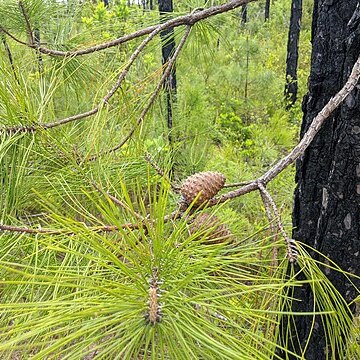Trees to 21 m tall; trunk to 0.6 m d.b.h. in native range, usually with adventitious sprouts; bark red-brown, irregularly furrowed into oblong, flat, scaly plates; crown often rounded or flat; branchlets orange-or yellow-brown, often glaucous, stout; winter buds red-brown, ovoid or narrowly ovoid, 1-1.5 (-2) cm. Needles tufted at branchlet tips, 3 (or 5 in adventitious or disturbed growth) per bundle, slightly twisted, (12-)15-21 cm × 0.3-1.5(-2) mm, stomatal lines present on all surfaces, fine, base with persistent sheath 1-2 cm, margin serrulate, Seed cones whorled, sessile or pedunculate (when peduncles to 1 cm), pale red-brown or creamy brown, broadly ovoid or globose when open, 5-8 cm, maturing in 2 years, late dehiscent. Seed scales with dark red-brown border adaxially distally; apophyses rhombic, low cross keeled; umbo with a short, weak prickle, sometimes unarmed. Seeds pale brown, mottled darker or nearly black, somewhat compressed, ellipsoid, 5-6 mm, apex oblique; wing to 2 cm.
Tree to 15(25) m; terminal buds very resinous; lvs in 3’s, dark green, flexible, 15–25 cm; cones divergent or somewhat reflexed, globose-ovoid, 4–6 cm, usually persistent and remaining closed for several years; apophysis thickened, the umbo conic, with a straight or reflexed spine ca 1 mm; seeds ca 2.5 cm. Swamps and wet soil, chiefly on the coastal plain; Fla. to se. Md. and s. Del., and reported from s. N.J.
A pine tree.


